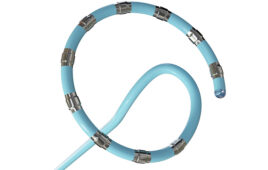Expanded polytetrafluoroethylene (ePTFE) is a flexible, biocompatible material, used to cover stents and stent grafts. The lubricity, strength, and durability of the material makes it valuable during stent deployment and in situ. But as the manufacturing processes for it have improved, it is seeing renewed interest in other vascular applications, including transcatheter heart valves.
Material benefits in clinical use
The material’s ability to collapse and expand repeatedly is critical to its use in vascular applications. ePTFE can cycle millions of times without breaking or coming off the device, which makes it valuable in the stent deployment process and resistant to wear in the body. It can adapt to blood vessels and their natural pulsatile action. Those pressure pulses create flexion that an encapsulated device must withstand.
ePTFE also features varying permeability, enabling outgassing while keeping blood cells flowing. It is chemically inert and hydrophobic. And its microporous nature encourages tissue ingrowth. Research has shown that endothelial cells that line all blood vessels can adhere and grow on ePTFE surfaces.
The material is also easy to work with, because of its temperature stability and its achievable thinness. Internal and external layers of coating measure in the micron scale, meaning that while the structure is deployed, it enhances the ability to navigate the vasculature but does not add significant thickness or diameter to the primary device.
Meeting manufacturing needs
One of the traditional challenges of ePTFE is overcoming slippage during application to the stent. Encapsulation, rather than coating, solves the problem for cylindrical devices as well as complex geometries. The biocompatible material is applied via batch encapsulation to enable quick manufacture while maintaining quality and cost and time savings. The encapsulation process is suitable for stent structures and other long-term implantable devices.
One of the benefits of the encapsulation process is that it enables very thin coverage of the stent, down to 0.0005 in. The encapsulation process can also accommodate conical shapes, flared shapes, and double flared shapes.
The ability to encapsulate complex geometries is a critical development in manufacturing. It avoids the need to suture material to the metal: ePTFE sticks to itself around the metal of the stent, without delaminating or tearing.
A key advantage in the process is the time and cost savings it offers over traditional manufacturing methods. These methods include hand sewing bovine or porcine valves to polyester, for example. Such a process is long and labor-intensive, and garners the appropriate premium pricing. Further, as skilled as a hand sewer may be, a person cannot achieve micron level accuracy or achieve micron thicknesses. By contrast, in the time that it takes for 3 hand-sewn devices to be ready, the ePFTE encapsulation might produce hundreds of units that are substantially thinner.
What’s next
As minimally invasive vascular procedures advance, the catheter sizes used for valves and stents will get smaller. Encapsulated ePTFE can help innovators improve clinical outcomes, reduce costs, and reduce time to market.





